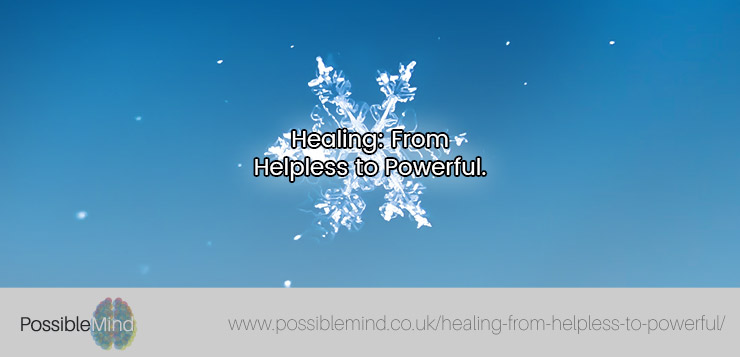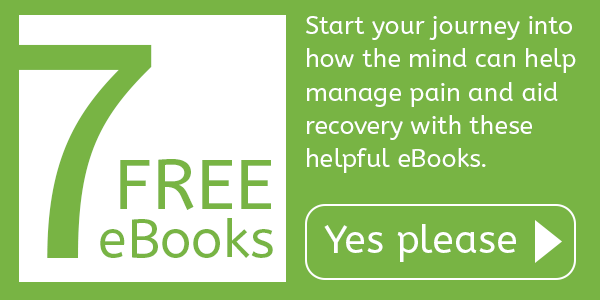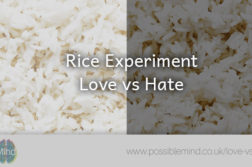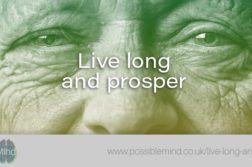Sometimes we can feel helpless and that everything is pre-determined and we are unable to make a difference, but is that really true?
This post is going to start with a humorous video that links to a beautiful story by Kurt Kauter. We will then discuss quotes from the Dalia Lama, Gandhi and Thich Nhat Hanh, along with a story about a New York Hospice which lead me to believe that we have much more control over our outcomes. Outcomes that have been unexpected time and time again because as mentioned in our last post, things may be “unlikely, but they are still possible”. It is not about the probability but the possibility that an outcome can happen.
This post then moves on to discuss what we can do to take control of our health. Based on extensive research, the information shared can help us to give ourselves the best chance of recovering from disease, cancer, illness, sickness or injury.
So let us start with the video I mentioned earlier. It shares a man placing individual elastic bands around a watermelon to see what happens. Have a watch because it will add to the story when you read it.
“Tell me the weight of a snowflake,” a coal-mouse asked a wild dove. “Nothing more than nothing,” was the answer.
“In that case, I must tell you a marvellous story,” the coal-mouse said. “I sat on a branch of a fir, close to its trunk, when it began to snow, not heavily, not in a giant blizzard, no, just like in a dream, without any violence. Since I didn’t have anything better to do, I counted the snowflakes settling on the twigs and needles of my branch. Their number was exactly 3,741,952. When the next snowflake dropped onto the branch–nothing more than nothing, as you say–the branch broke off.”
Having said that, the coal-mouse flew away. The dove, since Noah’s time an authority on the matter; thought about the story for a while and finally said to herself: “Perhaps there is only one person’s voice lacking for peace to come about in the world.”
~ from NEW FABLES THUS SPOKE–“The Caribou” by Kurt Kauter
Peace, health or any possible outcome each have a tipping point.
How wonderful to realise that each and everything has a tipping point that changes it from one thing to another. Like water tipping and changing into ice or steam.
With this knowledge, that by taking small incremental steps (like snowflakes or elastic bands) we can edge towards a complete change in our health with empowerment and optimism. As the famous Chinese proverb states ‘A journey of a thousand miles begins with a single step.’
Malcolm Gladwell wrote a book titled Tipping Point about this very subject in which he shares:
That is the paradox of the epidemic: that in order to create one contagious movement, you often have to create many small movements first.
This, to me, links with what the Dali Lama, Gandhi and Thich Nhat Hanh have to says about personal change and making a difference:
If you think you are too small to make a difference, try sleeping with a mosquito. – Dali Lama
Be the change that you wish to see in the world. – Gandhi
Because you are alive, everything is possible. – Thich Nhat Hanh
An event that took place in a New York Hospice helps highlight the difference, change and that pretty much anything is indeed possible:
For the first time in the hospice’s history, not a single person died in a calendar month, that month was December 1999. After the first week of January, when the numbers were high, all the figures went back to the expected rates.
All the signs discussed from the start of the article point to us being able to make a difference, but what steps can we take?
How we can reclaim our power of healing
Well, there are many.
As Viktor Frankl, the author of Man’s Search for Meaning describes that in life, people with a purpose are much more likely to survive and live longer than those with none.
Everything can be taken from a man but one thing; the last of the human freedoms – to choose one’s attitude in any given set of circumstances, to choose one’s own way.
This also includes our attitude towards our health, recovery and remission. So let’s now look at two different books and three experts to hear what steps they say we can take to change our attitude and give ourselves the best possible opportunity to heal.
According to Kelly Turner, a psychotherapist who specializes in integrative oncology, who in her book Radical Remission shares the 9 Key Factors and steps that all the people who have unexpectedly recovered from cancer did.
Before we hear the list of the 9 Key Factors, let’s clarify Kelly Turner’s explanation of Radical Remission which is:
- a cancer goes away without any conventional treatment;
- a patient begins with conventional treatment, then abandons this for alternative;
- or a patient uses both conventional and alternative at the same time
- One thing I would like to note is that I take issue with Turner’s use of the term alternative. In my mind, an alternative treatment is one that is used in place of (or as an alternative to) conventional medicine. When it is used alongside conventional treatment, I believe it should be called complementary or integrative.
Let’s bear this in mind, for just a moment, all of the many people who Kelly met that had a Radical Remission as shared above recovered with these…
…9 Key Factors
- Changing your diet
- Taking control of your health
- Following your intuition
- Using herbs and supplements
- Releasing suppressed emotions
- Increasing positive emotions
- Embracing social support
- Deepening your spiritual connection
- Having strong reasons for living
The amazing thing about this list is that we can do something about all them to give ourselves the best chance of reaching a tipping point of health or recovery from illness, disease or injury.
Kelly Turner’s list is extremely similar to another extensive study carried out in 1993 by Caryle Hirshberg and Brendan O’Regan from the Institute of Noetics who published Spontaneous Remission: An Annotated Bibliography. In this work, the authors defined spontaneous remission as “the disappearance, complete or incomplete, of a disease or cancer without medical treatment or treatment that is considered inadequate to produce the resulting disappearance of disease symptoms or tumor.”
Hirshberg and O’Regan could find no standard reference for the field of spontaneous remission. So in 1993 they created the Remission Project cataloguing the world’s medical literature on the subject and the resulting book is the largest database of medically reported cases of spontaneous remission in the world, with more than 3,500 references from more than 800 journals in 20 different languages.
In collating all their ‘Spontaneous Remission’ examples Hirshberg and O’Regan concluded that the vast majority of the people who experienced Spontaneous Remission shared 8 characteristics:
8 characteristics of Spontaneous Remission
- A change from dependency to autonomy combined with activities, attitudes, and behaviors that promote increased autonomy, awareness of themselves, others, and their environment, love, joy, playfulness, satisfaction, laughter, and humor.
- Facing the crisis, the despair, the sadness, and the pain and discovering they have the power to find a new way of life that is fulfilling and meaningful.
- Taking control of their lives, (personal, professional, emotional, spiritual, and medical) and living each day fully combined with a willingness to evaluate their beliefs and attitudes and change old beliefs and attitudes that are no longer appropriate or adequate.
- Becoming comfortable with and expressing and accepting both their positive and negative emotions/feelings, their needs, wants, and desires (physical, emotional, spiritual); the ability to say “No” when it is necessary for their well being.
- Having at least one strong loving relationship — a strong connection to another person, an activity, an organization(s), changing the quality of their interpersonal relationships with spouses, friends, family, neighbors, doctors, nurses, etc. in a positive way, and motivation to help others.
- Working in partnership with their physicians and participating in decisions related to their health and well being.
- Finding meaning in the experience of cancer, finding reasons to live, accepting the diagnosis but not the prognosis, seeing the disease as a challenge, belief in a positive outcome, and having a renewed desire, will and commitment to life.
- Choosing activities and practices that promote increased awareness and reduce stress (imagery, stress reduction, yoga, etc.); showing renewed spiritual awareness (Soul) that often results in a spiritual practice (prayer, meditation, religious affiliation, connection to nature, etc.)
As you can see, there are some distinct similarities in Kelly Turner’s 9 Key Factors of Radical Remission and Hirshberg & O’Regan’s 8 characteristics of Spontaneous Remission.
Let’s compare:
Kelly’s 9 Factor of Radical Remission in ‘Bold‘ with Hirshberg and O’Regan’s Spontaneous Remission’s in ‘Italics‘
- Changing your diet / Taking control of their lives, (personal, professional, emotional, spiritual, and medical)
- Taking control of your health / Working in partnership with their physicians and participating in decisions related to their health and well being. Choosing activities and practices that promote increased awareness and reduce stress (imagery, stress reduction, yoga, etc.)
- Following your intuition / Finding meaning in the experience of cancer, finding reasons to live, accepting the diagnosis but not the prognosis, seeing the disease as a challenge, belief in a positive outcome, and having a renewed desire, will and commitment to life.
- Using herbs and supplements / Taking control of their lives
- Releasing suppressed emotions / Becoming comfortable with and expressing and accepting both their positive and negative emotions/feelings
- Increasing positive emotions / Evaluate their beliefs and attitudes and change old beliefs and attitudes that are no longer appropriate or adequate
- Embracing social support / Having at least one strong loving relationship — a strong connection to another person, an activity, an organization(s), changing the quality of their interpersonal relationships with spouses, friends, family, neighbors, doctors, nurses, etc. in a positive way, and motivation to help others.
- Deepening your spiritual connection / Showing renewed spiritual awareness (Soul) that often results in a spiritual practice (prayer, meditation, religious affiliation, connection to nature, etc.)
- Having strong reasons for living / Taking control of their lives, (personal, professional, emotional, spiritual, and medical) and living each day fully combined with a willingness to evaluate their beliefs and attitudes and change old beliefs and attitudes that are no longer appropriate or adequate.
I will grant you, they are not an exact match, but the ethos and sentiment of both are extremely similar which clearly shows that we can each take the first step toward our tipping point of health and healing. Admittedly, the destination of that tipping point is not guaranteed. However, by starting that journey and following the 9 Key Factors of Radical Remission and the 8 Characteristics of the people who experience Spontaneous Remission, we will be giving ourselves the best chance. Therefore, empowering ourselves from a position of helplessness to one that gives us hope and a potential of recovery that we may not have considered before.
Conclusion
I now wish you the best on your journey towards the tipping point of health and I hope you are one of the many, like those discovered by Kelly Turner, Hirshberg and O’Regan, who reach their destination of remission.
When and if you do, be sure to share your story on Kelly’s website – www.radicalremission.com
If you like this post you will also enjoy:
- https://possiblemind.co.uk/the-body-knows-how-to-heal-itself/.
- Unlikely, but still possible.
- Mind Power and Belief for Recovery and Healing.
- How Athletes Recover Quicker Using Mind Power.
- The Healing Power of Illness Book Overview.
Further Reading:






